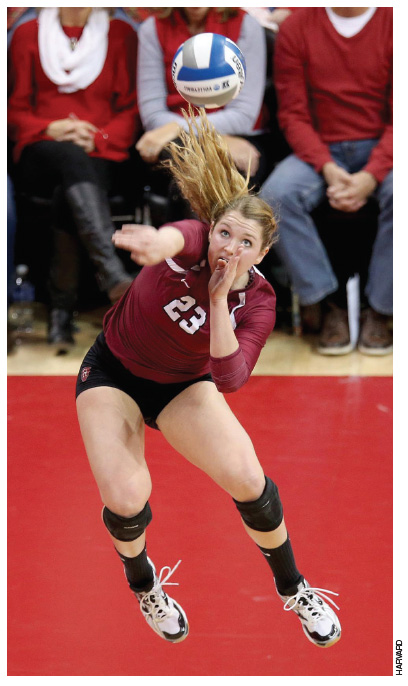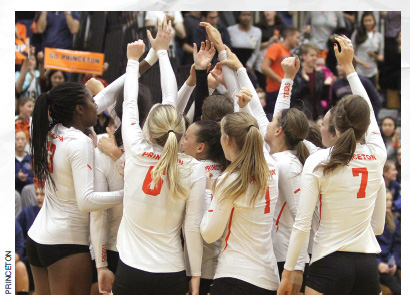| Dangerous Games - Risk Factors In The Sports Environment |
| By: Emily Kroshus
Originally Published In: Coaching Volleyball Magazine Provided by: AVCA Many mental health disorders are at least partially rooted in genetic biological predispositions (genetic vulnerability). However, genetic vulnerability is not destiny - environmental stressors and resources play a critical role in whether individual vulnerabilities turn into burdensome health conditions. By environment, we mean all of the factors outside the individual, ranging from their interactions with people close to them, to institutional policies and programs, to the broader culture within which they live, learn and play. Collegiate student-athletes face many of the same mental health risk factors as their non-athlete peers, but their roles as student-athletes both expose them to additional environmental risk factors and offer protective resources to help mitigate those factors. The environmental risks can take the form of direct stressors (for example, time demands, performance pressures, coaching style); interactions with others in their environment that encourage risk behaviors and discourage individuals from seeking help; harassment and discrimination related to personal characteristics such as race/ethnicity or sexual orientation; and exposure to interpersonal or sexual violence. The protective factors can include prevention and screening programs, and interactions with others that encourage individuals to seek help. These risk and protective factors are introduced briefly below, and then discussed in greater detail later in the chapter in essays from leading clinicians. Sport-related stressors Stress is not inherently bad. In fact, in many cases it is a healthy part of growth. However, if it is chronic or inadequately managed, it can result in negative health outcomes either directly or through unhealthy coping behaviors (such as substance abuse). Interactions, resources, policies, programs and cultural attitudes in the sport environment have the potential to reduce the presence of stressors and to help student-athletes deal effectively with them. Time demands are a frequent source of stress for student-athletes. Many student-athletes spend more than 30 hours per week on their sport, with extensive in-season travel and early morning practices that limit sleep. Managing both sport and academic demands often results in elevated stress, inadequate sleep, and an inability to participate in other extracurricular or leisure activities that help promote overall well-being. Because of the physical demands on their sport, many student-athletes need more sleep than the average college student. Individuals with adequate sleep also respond more effectively to stressors as they arise. Research has indicated that sleep is critical for mental acuity, sport performance and injury prevention. Another frequent source of stress is pressure to perform athletically. Some of this pressure is self-imposed. When sport is central to identity, so is sport performance. Pressure often comes from outside sources, most critically from coaches. Coaching style plays a role. When coaches use an ego/performance-centered motivational climate (as compared with a skills-mastery motivational climate), student-athletes tend to experience greater anxiety and distress, and are at elevated risk of negative outcomes, including burnout and disordered eating. Institutional policies matter, too. Athletics scholarships put a dollar value on athletics performance, and policies related to scholarship reductions heighten performance-related pressure for student-athletes, particularly those with financial need. Interactions with parents, peers and fans can put a premium on athletics performance and a microscope on failure to perform athletically. The growing use of social media allows alumni and other fans to interact with student-athletes directly, and can have the result of exacerbating this pressure. Normative behaviors Interactions with teammates can be a source of risk or protection. Adolescents and young adults often place a high value on peer approval and in looking and acting like their peers. For student-athletes, this often means teammates. The stronger the group's identity and cohesion, the more important individuals tend to find conforming to the group's norms.
Another way in which teammates and others in the sport environment can influence mental well-being is in the extent to which mental health issues and help-seeking are stigmatized or encouraged. If teammates and coaches stigmatize mental health conditions or encourage a culture of toughness and not admitting weakness, symptomatic or at-risk individuals will be less likely to disclose their mental health conditions or seek help. Conversely, teammates who don't stigmatize disclosure of mental health conditions and who encourage help-seeking can be powerful positive forces. Coaches can play a critical role in serving as a resource for student-athletes who want to discuss mental health issues, and in encouraging or discouraging help-seeking for these issues. Harassment and discrimination Minority populations, including racial/ethnic minorities and sexual minorities, often experience negative mental health outcomes connected to their experiences with harassment and discrimination. While some sport environments may be fully inclusive of all minority groups, others are not. Additionally, while the sport environment is a critical one for student-athletes, it is not the only environment in which they function. Even when a sport environment is fully inclusive, student-athletes from minority populations who are stigmatized or who experience more overt forms of harm such as verbal harassment and violence in nonsport environments can experience negative health consequences. For example, sexual minority college students tend to experience more anxiety and mood disorders, engage in more frequent suicidal ideation, and make more suicide attempts than their heterosexual peers. The Minority Stress Model has helped explain this difference. Acute and chronic stressors - including violence and harassment and the fear of violence and harassment occurring - as well as internalized stigma lead to physiologic responses, such as elevated cortisol levels. These physiologic processes can have direct bodily harm. They can also increase the risk of maladaptive coping behaviors such as substance abuse. In addition to ensuring that sport environments are free of harassment and discrimination of minority populations, coaches, clinicians and others who interact with student-athletes need to be aware that individuals of minority status may be shouldering a heavy load from their experience functioning outside the sport environment. In some cases, it may be appropriate to engage resources to help athletes cope with these external sources of stress, or at the very least to function in a supportive and understanding role. Interpersonal violence Experiencing interpersonal violence, particularly sexual violence, can have lasting mental health consequences. Recent evidence from the National Collegiate Health Association indicates that nearly 10 percent of female college students have been sexually touched without their consent during the past 12 months, with no significant differences between athletes and non-athletes.
The sport environment matters for both risk and prevention of mental health disorders. Unique stressors often accompany the experience of being a student-athlete. Resources in the sport environment can potentially mitigate stressors and encourage help-seeking for individuals who are experiencing mental health disorders or who are at risk of these disorders. Student-athletes benefit from being part of the sport family - with teammates and coaches who see them on a daily basis. Whereas many students transitioning to college run the risk of being isolated and not finding a supportive community, college student-athletes often have a built-in community from the moment they step foot on campus. Student-athletes are often used to working with a team of multidisciplinary health care professionals to facilitate optimal health and sport performance. Coaches, athletic trainers and teammates can reinforce to symptomatic individuals that mental health professionals are just one more piece of this equation. Student-athletes are also used to adhering to routines and dealing with aversive conditions rehabilitating injuries - and receiving support from teammates and coaches during this process. The process of recovery from mental health disorders can in some cases be similarly onerous - and social support matters a great deal here, too. Drawing on the experience of recovering from other health- and performance-impacting injuries in the sport environment can help more positively frame mental health-related treatment-seeking and adherence for the symptomatic individual. While the sport environment presents numerous risk factors for student-athlete mental health, it can also play an important role in prevention and wellness. Reducing unnecessary sources of stress and stigma in the sport environment, increasing access to resources to help mitigate stress, and encouraging help-seeking for mental health disorders are all critical ways in which the sport environment can function to improve mental well-being among student-athletes. While the sport environment presents numerous risk factors for student-athlete mental health, it can also play an important role in prevention and wellness. Reducing unnecessary sources of stress and stigma in the sport environment, increasing access to resources to help mitigate stress, and encouraging help-seeking for mental health disorders are all critical ways in which the sport environment can function to improve mental well-being among student-athletes. |




 An excerpt from the Sport Science Institute's guide to understanding and supporting student-athlete mental wellness
An excerpt from the Sport Science Institute's guide to understanding and supporting student-athlete mental wellness Sports teams often have extremely high group identity and cohesion. When some teammates model unhealthy behaviors, such as disordered eating or substance use, other teammates are at elevated risk of adopting those behaviors. Whether exposure to or experimentation with these types of unhealthy behaviors results in an individual progressing to a clinically diagnosable mental health disorder depends in part on his or her underlying genetic vulnerability. However, environment matters a great deal.
Sports teams often have extremely high group identity and cohesion. When some teammates model unhealthy behaviors, such as disordered eating or substance use, other teammates are at elevated risk of adopting those behaviors. Whether exposure to or experimentation with these types of unhealthy behaviors results in an individual progressing to a clinically diagnosable mental health disorder depends in part on his or her underlying genetic vulnerability. However, environment matters a great deal. Sexual minority students - both male and female, athlete and non-athlete - experienced significantly higher rates of sexual assault within the past 12 months than those who did not identify as lesbian, gay, bisexual or transgender. Individuals who self-reported experiences of sexual assault were significantly more likely to struggle academically, find it hard to handle intimate relationships, and experience hopelessness, mental exhaustion, sleep issues, depression and suicidal thoughts.
Sexual minority students - both male and female, athlete and non-athlete - experienced significantly higher rates of sexual assault within the past 12 months than those who did not identify as lesbian, gay, bisexual or transgender. Individuals who self-reported experiences of sexual assault were significantly more likely to struggle academically, find it hard to handle intimate relationships, and experience hopelessness, mental exhaustion, sleep issues, depression and suicidal thoughts.


